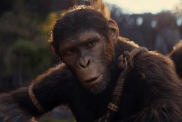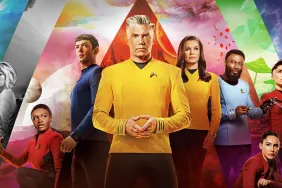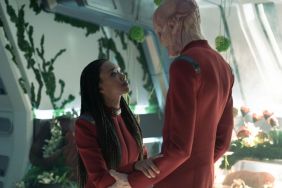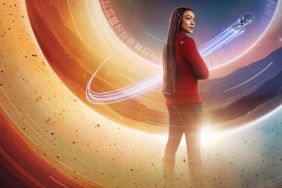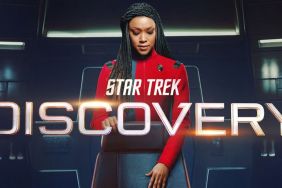One of the challenges facing any would-be “Star Trek” fan without an existing foothold in the franchise is the sheer volume of material out there. Even discounting the countless tie-in novels, comic books and video games, there are still hundreds of hours of “canon” Trek, split between six television series and 12 feature films. If J.J. Abrams’ Star Trek Into Darkness is one of your first experiences with Gene Roddenberry’s fictional universe, this guide is designed to point you in the right direction to either continue the experience or, at the very least, help you appreciate some of the inside jokes that pop up in the new blockbuster. Please be aware, however, that the below information contains spoilers for both the new film and for several series storylines as well. Please proceed at your own discretion.
The most important thing to realize about “Star Trek” is that, despite its massive scale, it is at its heart, an anthology series designed to showcase science fiction ideas. In fact, it was policy on every series up until “Enterprise” in 2001 to accept unsolicited screenplays from fans, some of which wound up becoming actual episodes. Although ongoing arcs do appear, particularly in later series, all you really need to know to access most episodes is that “Star Trek” is about explorers and their encounters with strange new worlds, new life and new civilizations.
THE GORN
In Into Darkness, Dr. McCoy mentions that he once delivered Gorn octuplets. What’s a Gorn? Check out “Arena,” the 18th episode of the original series to see Starfleet’s first encounter with the vicious reptilian race. The episode finds the Enterprise attempting to pay a visit to a distant outpost, only to learn that the base has been obliterated by the Gorn. When a starship battle threatens to break out between the Enterprise and a Gorn ship, the conflict attracts the attention of the Metrons, omnipotent beings that force both ships’ captains to settle their difference through hand-to-hand combat on the planet’s surface. Whoever loses will have their entire ship destroyed by the all-powerful race.
The Gorn have been one of the most popular races in “Star Trek” lore but, while frequently referenced, have only actually appeared in two other episodes. An unnamed Gorn can be seen in what is essentially a cameo capacity in the animated episode “The Time Trap” and one appears in the fourth season “Enterprise” episode “In a Mirror, Darkly, Part II.” The Gorn are also heavily featured in the new “Star Trek” video game, set in the Abrams’ timeline and taking place directly before the events of “Into Darkness”.

TRIBBLES
“The Trouble with Tribbles” is the 34th episode of the original series and introduces the furry creatures that are equally adorable and menacing. Although they appear to be nothing more than soft, purring balls of fluff, Tribbles are actually born pregnant and breed at an exponential rate, threatening to quickly overtake entire starships. In the episode, the Enterprise crew manages to overcome the Tribbles mercifully and even uses them to capture Klingon spies attempting to sabotage an important supply delivery to a Federation colony.
Tribbles return in “More Tribbles, More Troubles,” a light-hearted animated episode wherein genetic engineering has created the “safe” Tribble. Instead of multiplying, however, these ones just get bigger and bigger and bigger.
Tribbles also appeared in an incredible 30th anniversary episode of “Star Trek: Deep Space Nine,” titled “Trials and Tribble-ations.” When the Klingon spy from “The Trouble with Tribbles” decides he wants revenge against Kirk, he winds up hurling himself and the DS9 crew back in time to the actual “Trouble with Tribbles” episode. Forrest Gump-style green screen effects allow the modern cast to go undercover in the background of the original episode, turning the whole affair into one of the funniest and most loving Trek episodes to date.

KLINGONS
The most famous recurring villains of the original series, Klingons are a warrior race who hold personal honor above all else. They make their first appearance in the episode “Errand of Mercy,” where an Enterprise away team goes undercover on a seemingly primitive alien world being occupied Klingon troops.
Star Trek VI: The Undiscovered Country is effectively a political thriller that treats the conflict between Earth and the Klingon Empire as a metaphor for the Cold War. When the Klingon moon, Praxis, explodes, the empire is unable to sustain itself without the Federation’s aide and peace talks begin that, by the time of “The Next Generation,” have even led to a Klingon officer, Worf, serving aboard the Enterprise.
Although used pretty much exclusively as antagonists in the original series, later Trek ends up fleshing out Klingon culture to an incredible degree, offering a look at Klingon art, science and world history.
“Into Darkness” reveals a puzzling twist to the Trek canon, as it appears that, in the new timeline, Praxis exploded several decades earlier than it did in the original continuity and the remains can be seen orbiting Qo’noS.
Redesigned for Star Trek: The Motion Picture, there’s a big visual discrepancy between the Klingons of the original series and those featured in subsequent Trek adventures. Read on for where to find the official explanation!

HARRY MUDD
Into Darkness references a shuttle being left in the Enterprise’s bay after the “Mudd incident.” Harry Mudd (short for Harcourt Fenton Mudd) was one of the original series’ few recurring antagonists. More a pain-in-the-neck than a straight-up villain, Mudd (played by Roger C. Carmel) first visits the Enterprise with three beautiful and mysterious ladies in the series’ sixth episode, “Mudd’s Women.” Although he claims to be delivering mail-order brides, the whole affair quickly turns out to be one of Mudd’s trademark schemes. He then returns in the second-season episode “I, Mudd,” having somehow become the ruler of a planet of Androids. Carmel played the role one more time, lending his voice talents to an animated episode, “Mudd’s Passion,” wherein Mudd causes havoc on the Enterprise with black market love-crystals.
Fans following the Abrams-verse tie-in comic books, however, will know that the Mudd referenced in the film is actually an altogether different character. The four-issue “Countdown to Darkness” series is set directly before the new film and reimagines Mudd as a Bajoran woman.

NURSE CHAPEL
A regular character on the original series, Nurse Christine Chapel was played by Majel Barret Roddenberry (the wife of Trek creator Gene Roddenberry). Chapel first appears in “The Naked Time” and is repeatedly shown as having an unrequited love for Spock. Into Darkness has Marcus mention that she transferred to another ship after things went sour between Chapel and Kirk.

CAROL MARCUS
Played by Bibi Besch in Star Trek II: The Wrath of Khan, Carol Marcus is a Federation scientist and the mother of Kirk’s son, David. After David was born, the lovers went their separate ways and David was raised without knowledge of his father. Into Darkness casts Alice Eve in the role, offering a glimpse at a younger version of Marcus that Trek fans have never seen before. There’s even a very specific inside joke in the film that references the character’s origins.
When Marcus comes aboard the Enterprise in the new film, she uses the fake last name Wallace. Dr. Janet Wallace was a character played by Sarah Marshall in the original series episode “The Deadly Years.” An old flame of Kirk’s, Wallace was featured in early drafts of Wrath of Khan in what became the Carol Marcus role.
In the original series’ second pilot, “Where No Man Has Gone Before,” Kirk references that he almost married a “blonde lab tech.” Fans debate to this day whether he meant Wallace, Marcus or, knowing Kirk’s penchant for the ladies, another woman altogether.

THE PRIME DIRECTIVE
The Prime Directive, Starfleet’s guiding principle, is effectively a “live and let live” rule that says that, despite whatever philosophies or ideals the United Federation of Planets may represent, they have no right to inflict their views on outside cultures, particularly cultures that have not yet mastered warp technology and discovered space travel for themselves. On frequent occasions, however, the Prime Directive runs the risk of becoming a “live and let die” rule and some of the very best Trek episodes involve exploring moral conflicts between differing ideologies.
For the very first mention of the Prime Directive, check out the original series episode “The Return of the Archons.” In it, the Enterprise crew has to infiltrate a pre-warp planet in disguise to figure out whether the mysterious force manipulating the culture is of extraterrestrial origin without allowing their own influence to affect the planet’s development.
Although the Prime Directive is not explicitly mentioned in the episode, “A Taste of Armageddon” is one of the original Trek’s very best looks at ideological divergence. The Enterprise finds itself traveling to the war-torn Eminiar VII to open diplomatic relations. The planet, it turns out, has an evolved look at warfare and, rather than fight actual battles that risk destroying the world’s culture, a computer simply calculates the precise fatalities of strategic combat and members of both sides willingly turn themselves over to be disintegrated.
If the conclusion of the Nibiru sequence in Into Darkness interests you, watch “The Next Generation” episode “Who Watches the Watchers?” wherein Captain Picard finds himself in the same situation of having an underdeveloped world accidentally begin worshiping him and his crew as gods.
“The Next Generation” feature film Star Trek: First Contact also offers a nice reverse, putting Earth on the receiving end of the Prime Directive. Thanks to a time travel setup, we get to witness Earth’s very first warp flight 50 years from now and see how, by mastering the technology, our planet makes contact with the Vulcans and begins to discover its place in a much larger universe.

KHAN
If you’ve seen Into Darkness with a “Star Trek” fan, you’ve likely heard them grumble about the discrepancies between Benedict Cumberbatch’s Khan and the version played by Ricardo Montalban in the original series episode “Space Seed” and the feature film Star Trek II: The Wrath of Khan. Although Montalban is himself Mexican, the character of Khan is supposed to be of Indian descent and was the result of genetic engineering experiments in the late 20th century that led to a catastrophic conflict known as “The Eugenics War.” Khan, a charismatic and vengeful leader, was said to be responsible for 35 million deaths before the war ended in the 1990’s with rumors persisting that Khan may have actually escaped in one of several cryogenically frozen sleeper ships.
“Space Seed” picks up nearly 300 years later and has the Enterprise coming across Khan’s vessel, the Botany Bay, and accidentally reviving the villain. Although Khan attempts to take over the Enterprise and even woos the ship’s female historian into joining him, he’s stopped and, by way of a small mercy on the part of Kirk, marooned on the uninhabited Earth-like planet Ceti Alpha V to rule as he sees fit.
The Wrath of Khan picks up 15 years later, revealing that a solar disaster quickly turned Ceti Alpha V into a hellish wasteland. Khan, barely surviving all these years, has turned all his hatred to Kirk, the man he feels responsible for his fall from grace. Once he makes it to a starship, Khan is able to exact a revenge that plays pretty much parallel to the events of Into Darkness, albeit with a far darker conclusion.
Although Khan himself is not featured, references to the Eugenics War pops up in a few more Trek episodes, including the three-part “Enterprise” arc “Borderland,” “Cold Station 12,” and “The Augments.” Guest-starring Brent Spiner as Dr. Arik Soong, the grandfather of the scientist who will one day build “The Next Generation’s” Data, the episodes follow another sleeper ship from the the ’90s and the illegal research Soong undertakes in an effort to study the newly-awakened crew. Those episodes lead directly to a two-parter later in the season, “Affliction” and “Divergence,” where Soong’s research is used by Klingon scientists, ultimately explaining why original series Klingons look so different from Klingons shown in later series.
The name John Harrison is likely inspired by John Ericssen, which was to be Khan’s name in an early script for “Space Seed.” Although there are quite a few discrepancies to reconcile between the original Khan and Cumberbatch’s take, one potential tease of a solution lies in the “Star Trek: Voyager” two-parter “Future’s End” where the ship is thrown back in time to present day (then 1996) Earth and there are no signs of the global conflict anywhere. Given that no one in Into Darkness seems to recognize Khan as one of history’s great monsters, it’s a good bet that it won’t be long before Trek fans find a way to turn those two continuity wrongs into a right.
The Eugenic War also leads to an incredible mid-series twist in the “Deep Space’s Nine” episode “Doctor Bashir, I Presume,” revealing that one of the series regulars, Dr. Julian Bashir, was genetically modified as a child: a crime that carries significant consequences in the Star Trek universe.

SECTION 31
Most of the alien races in the Star Trek universe have their own top-secret agency. The Romulans have an organization called the Tal Shiar and the Cardassians have the Obsidian Order. In the “Deep Space Nine” episode “Inquisition,” we learn that Starfleet has one of their own and that they’ve been operating in secret since the birth of the Federation. Much like how Admiral Marcus recruits Khan, Section 31 reaches out to the genetically-modified Bashir, attempting to make him an agent. Section 31 returns soon thereafter in “Inter Arma Enim Silent Leges,” an episode that explores the darker side of Starfleet, living up the latin title that translates to, “In times of war, the law falls silent.”
Although it doesn’t include Section 31, one of DS9’s very best stories is “In the Pale Moonlight,” fits thematically with stories of Starfleet’s dark side. The episode has the station’s Captain, Sisko, finding himself going to some very immoral extremes in an attempt to achieve the greater good.
“Enterprise” brings back the organization, showing how it affected the early days of Starfleet by making one of the regular characters a secret Section 31 agent. Because the series takes place prior to the Abrams split universe, “Enterprise” can be seen as a direct prequel to the two most recent films. Not only does the two-parter that closes out the series, “Demons” and “Terra Prime,” feature Section 31, it stars Into Darkness‘ Peter Weller as John Federick Paxton, a villainous leader of a xenophobic hate group, Terra Prime, that wants to see Earth cut off all ties with alien races, not all that disimilar to Marcus’ desire to start a war with the Klingon empire.
Of course, there are hundreds of other great Trek episodes that aren’t referenced in Into Darkness and, thankfully, just about all of them are available through a variety of streaming services. One of the tenants of Vulcan philosophy is IDIC, an acronym that stands for “Infinite Diversity in Infinite Combinations.” That’s a very good way to think about the franchise as whole, so jump right in wherever you feel comfortable and don’t worry too much about not knowing the universe. After all, exploration is the whole point in the first place.

